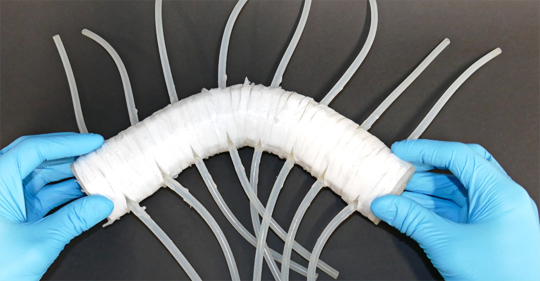Lifelike artificial organs
Freiburg, May 05, 2021
The Freiburg researcher Dr. Falk Tauber has succeeded in reproducing lifelike muscular activity of the esophagus and intestines using soft robotics. As a result, these models are not only in demand as artificial organs for the development of medical products, but could also pose as convenient replacement organs for superheroes.

Flexible replica: Esophagus and intestine are also a good biological model for pump systems in e-mobility. Photo: Plant Biomechanics Group Freiburg
Biologist Dr. Falk Tauber has been haunted by a certain question for quite some time now: “As a scientist, I ask myself how I can explain my work in such a way that it arouses enthusiasm and is really understood without it becoming too complicated or trite?” The postdoctoral researcher is conducting research on material systems of the future and bioinspired technologies at the Freiburg Cluster of Excellence Living, Adaptive and Energy-autonomous Materials Systems (livMatS) and the Plant Biomechanics Group Freiburg. When describing his projects, he wants to find middle ground between “I'm researching biomimetic, peristaltic soft robotic pump systems” and “I work with tubes.”
Tauber found the answer to his question when he met Barry W. Fitzgerald from Eindhoven University of Technology in the Netherlands at a conference. Fitzgerald not only shared Tauber’s enthusiasm for Marvel comics, but is also the science communication officer at his university. Fitzgerald has already written so much about the science behind the fantastic powers of superheroes that he calls himself a “Superhero Scientist.” When he heard about Tauber’s work and suggested that he think it through so that he could fulfill one of his popular superhero’s long-cherished wish, Tauber was immediately on board. After all, he still remembers well how his own enthusiasm for bionics was awakened: by the so-called Gecko Tape. This microstructured silicone film with numerous adhesive elements not only explained how Spiderman could climb smooth walls, but was also presented to the public with precisely this reference.
Gravity-defying transport
Like the Gecko Tape, Tauber’s research found its origins in a biological model. In his case, it was the question of how the esophagus and intestines can transport what flows through them, even against gravity, without additional pumping systems. According to Tauber’s thinking, it would be a good biological model for e-mobility: if cooling or other liquids can be moved by self-pumping tubes, the weight of motors can be further reduced by making additional pumping systems dispensable. The Freiburg scientist will continue to pursue his research in this direction, but Fitzgerald’s initial suggestion to think in terms of superheroes in his work proved to be very fruitful.
After all, once you have developed novel pump systems modeled on the esophagus and intestines, you can use them as such. Not in humans as the materials are not yet suitable for that. But a superhero like Vision, an android whose energy supply is provided by a magic stone, could finally be able to enjoy the soups he cooks for his superhero girlfriend in the comics himself with the help of an artificial digestive system. When Tauber set out to expand his previous research findings into a functioning digestive system, it was clear that the benefits could not only be enjoyed by fictional characters.
The Freiburg biologist has already constructed the esophagus and intestine in principle. The great challenge here was to reproduce the sequence of ring-shaped muscle contractions with which the esophagus transports its contents. In addition, Tauber had to investigate how kinking or contractions occur in intertwined systems such as the intestine. The models that Tauber developed are so close to their biological counterparts that they have aroused great interest in medicine. There, they can be used as artificial intestines to develop sensor systems for medical technology.
The intestines as a role model for energy production
The idea of providing the super android Vision with an artificial digestive tract that would supply it with energy and nutrients based on the human model inspired Tauber to think about how he could supplement his intestinal model with artificial microbiomes based on lab-on-a-chip systems to create a functioning energy production system. He has already succeeded in terms of mechanics. “We can transport food to the rectum through artificial ring muscles in the typical undulating movements like an esophagus. And the sphincters are no problem either,” Tauber explains. He has limited the organ functions to the stomach, where food is chemically digested and then can be processed through microfluidic, cellular systems. “It is still a far reach from the human model, but practical applications are emerging, such as in wastewater treatment plants or for domestic energy production.”
Currently, Tauber’s artificial esophagi and intestinal coils are pneumatically operated, which requires a certain amount of space. But now that the principle is understood, new techniques can be developed to steadily improve it. Perhaps Dauber’s system won’t provide the superhero Vision with the full pleasure of human digestion. But it might already be able to replace the magic stone that provides the superhero’s energy.
Jürgen Reuß
Publication “How to build a synthetic digestive system for Marvel's Vision”
livMatS – Living, Adaptive and Energy-autonomous Materials Systems
livMatS is one of two Clusters of Excellence at the University of Freiburg. Within these clusters, 28 research groups are developing novel bioinspired material systems that can autonomously adapt to different environments, extract clean energy from them, and compensate for damage. The scientists come from six faculties - the Faculty of Engineering, the Faculty of Chemistry and Pharmacy, the Faculty of Biology, the Faculty of Mathematics and Physics, the Faculty of Economics and Behavioral Sciences and the Faculty of Philosophy. The Fraunhofer Institutes for Solar Energy Systems ISE and for Mechanics of Materials IWM as well as the Ökoinstitut e.V. are also involved. The German Research Foundation will provide funding for the cluster from the beginning of 2019 until the end of 2025.

